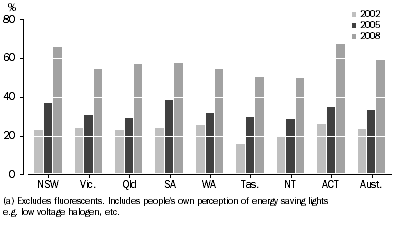LIGHTING
The type of lights chosen by a household affects the amount of electricity used. One means of conserving energy is through the use of fluorescent light bulbs and energy saving lights, including compact fluorescent light bulbs. A compact fluorescent light is based on the standard fluorescent lamp and is designed to fit into a conventional light socket. Fluorescent lights and compact fluorescent lights are considered the most energy efficient form of lighting, as they use less energy, are cheaper to operate and can last up to 10 times longer than conventional lights (DEUS 2008).
In 2008, more than half of dwellings (58%) in Australia used fluorescent lights or other energy saving lights (59%) in at least one room (table 2.20). In the Northern Territory, fluorescent lights were used in 82% of dwellings and in Queensland, 72% of dwellings. Use of fluorescent lights in homes was less common in capital cities (53%) than in the rest of Australia (67%), and use of other energy saving lights was slightly lower in capital cities (58%) than in other parts of the country (60%). Nationally, one in five dwellings (22%) had compact fluorescent lights in every room, while in the Australian Capital Territory it was one in three dwellings (32%) (table 2.22).
While the use of fluorescent lights remained fairly steady between 2005 and 2008 (table 2.21), there was a significant increase in use of other energy saving lights over the same period (from 33% to 59%), particularly in the Australian Capital Territory (from 35% to 67%), New South Wales (37% to 66%) and Victoria (31% to 54%) (graph 2.4).
2.4 Energy saving lights(a), Use in dwellings
